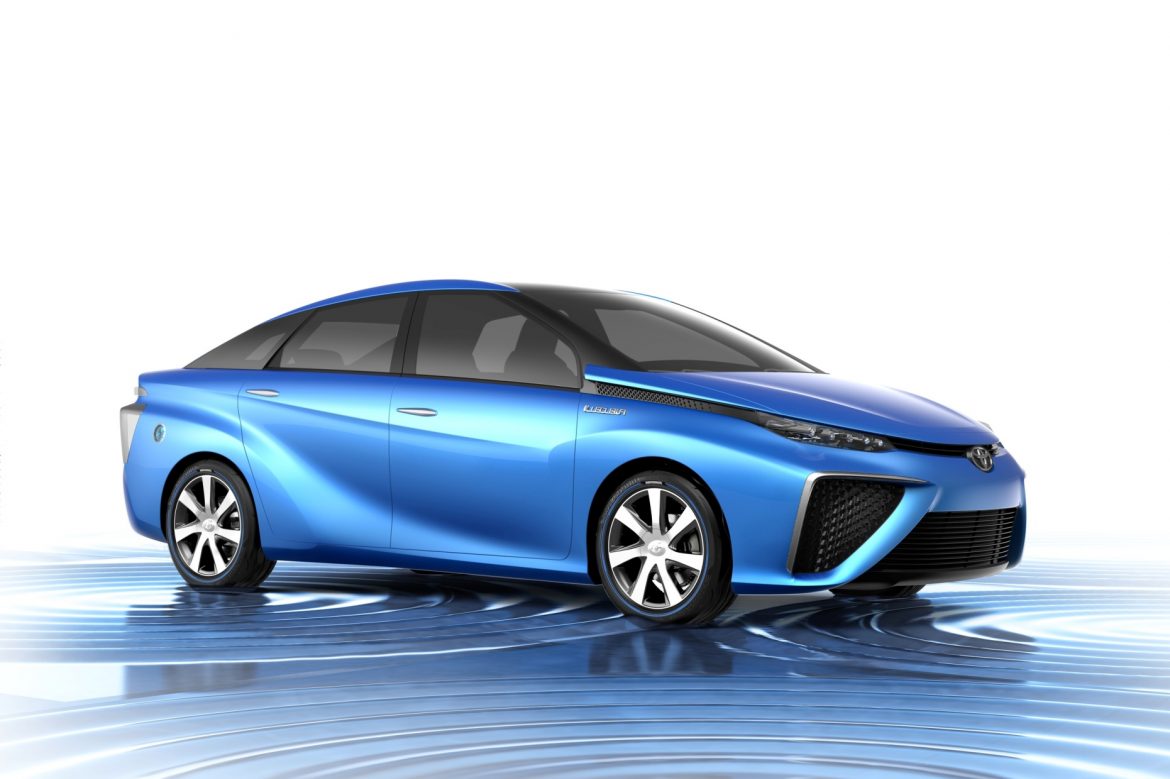
Cheap Fuel Breakthrough From Stanford… Hydrogen Cars Gear for Market Debut
Everyone’s dream is to sit behind the wheel of a flashy electric car purring silently on hydrogen. And leading automakers in Japan, Europe and the U.S. are revving up on the start line to pour out the new generation of these “green” cars running on hydrogen fuel cells and emitting water vapor instead of toxic exhaust gases which pollute the air and contribute to global warming. Japan’s automotive heavyweight Toyota is poised to lead the pack with its sleek concept car. The sales of the Toyota FCV sedan (above) in areas with hydrogen stations before May 2015.
Don’t be in a hurry to close your eyes not to see the price tag to wreck your dream. This car, which you could hope to buy only if you were rich enough to write seven-digit cheques and were school chums with the CEO of the company a decade ago, will not cost you more than 70.000 dollars in Japan.
And now, a technique developed by Stanford University scientists may well make that dream come true not just for the fat cats, but for everyone: by electrolysing water with minimal energy at room temperature! With cheap catalysers used by researchers, the process can be powered just by a single 1.5 volt battery.
When can the dream come true? Ten years back, General Motors had made the ambitious claim that it would be the first company selling 1 million hydrogen-powered cars by mid-2020s. But although such mainstream automakers as Toyota, Honda, Mazda, Ford, Mercedes and BMW have begun unveiling state-of-the-art hydrogen cars and Industrial heavyweights like the U.S., Japan, the European Union and China are investing sums ranging from hundreds of millions to billions of dollars in the field, engineering, cost and infrastructure bottlenecks make clear that widespread use of these cars will not be possible before 2030s. A few of the problems needing to be addressed:
– The U.S.hydrogen production (for gasoline reforming and chemical plants) is 9-10 million tons, a tiny fraction of what is needed for a “hydrogen economy.”
– For hydrogen replacing oil products to power 40 percent of cars in the U:S, an investment no less than 600 billion dollars is needed, say Argonne National Laboratory researchers .
– Chicken or egg problem: Whether affordably priced hydrogen cars will cause filling stations to proliferate or whether a thick enough network of stations will stimulate mass production of these cars remains unanswered. “I won’t change my car before seeing a hydrogen station at every corner,” say many consumers. But even in “green minded” California, the number of these stations does not exceed 20 or 30.
– Storage: Because it is such a volatile gas, hydrogen requires 3000 times more room than gasoline of the same volume. Hence, to fill a car with hydrogen fuel enough for long-distance travel, tanks should be able to withstand pressures of up to 700 atmospheres. Even fuel tanks that strong can have a volume eight times that of a gasoline-driven car.
– Transport: hydrogen with the energy equivalent of a tankerful of gasoline requires 21 tankers for transport. If the tanker also runs on hydrogen, it needs to consume 40 percent of its load for every 500 km. Cooling for transporting in liquid form requires prohibitive amounts of energy. As for pipelines, they need pumping stations every 150 km. If each consumes 1.4 percent of the carried fuel, a pipeline a few kilometers long will end up using 30-40% of the fuel. . And hydrogen production throug electrolysis at filling stations (to service for 2000 cars) requires an energy consumtion of about 80 megawatts of electricity.
Hydrogen, although virtually non-existent in Earth’s atmosphere (having dispersed to space long ago, being the lightest element) , abounds in nature tied to other elements in molecules, including water which covers two- thirds of the planet’s surface. Hence, it can be obtained by electrolysing the water or reacting it with other molecules. But even leaving the engineering, cost and infrastructural hurdles, both methods involve the use of fossil fuels and produce greenhouse gases!
One of the two main methods employed today for use of hydrogen to power l cars, is burning the fuel, pumped into your car’s tank in hydrogen stations, inside the internal combustion engines (ICE) just like gasoline. The other, is feeding it to fuel cells. In fuel cell technology, what’s done is exactly the opposite of water’s electrolysis. As hydrogen combines with oxygen in the air, it generates electricity and potable water comes out as the only by-product instead of the carbondioxide emitted by fossil fuel burning motors.
Hydrogen cars, however, are expensive compared to ordinary cars running on fossil fuels. The reason is the high cost of critical components of fuel cells (under the current technology) as well as the hydrogen fuel stored in those cells.
In today’s technology, hydrogen is obtained mainly by “reforming” natural gas or methane (CH4) by water vapor at temperatures of 700 – 1100 ⁰C in the presence of a metallic catalyser (usually nickel), separating it into carbon monoxide and hydrogen. Carbon monoxide, a toxic pollutant, then contributes to hydrogen production by reacting with water, the process producing , this time, greenhouse gas carbon dioxide!
Besides using natural gas, a fossil fuel, as the raw material for a clean fuel, the technology relies on energy produced by fossil fuel-burning power plants to heat the steam.
The extreme volatility of hydrogen, requires its forcing into fuel tanks either as gas or a liquid (after being cooled to -252.87 ⁰C), which, in turn, requires expensive fuel tanks which can withstand high pressures.
Water or fire? Two rival concepts compete for powering hydrogen cars. First one is internal combustion engines which work like those in gasoline-driven cars, but use a mixture of hydrogen and air instead of the air-gasoline mix used in conventional engines. These are called H2 ICE deniyor. The other relies on fuel cells which combine hydrogen with oxygen via platinum catalysers to produce electricity (and water.) Pros and cons: Since the chemical energy stored in hydrogen is much higher compared to gasoline, H2 ICE engines are more efficient. They can use up to 70 percent of the energy contained in the fuel (the ratio drops to about half in fuel cells, and a mere 25 percent in gasoline cars.) But as the lighter hydrogen fuel takes up far more space, enough air (and oxygen) cannot enter the combustion cylinder. Furthermore, since hydrogen is highly inflammable, it readiy ignites in the presence of a heat source, and even when approaching a sparkplug. This causes the engine to “cough” or even backfire. To cope with the problem, Ford have developed a component it calls “supercharger” which forces 1.5 times the normal amount of Fuel-air mixture into the cylinder. Other producers employ other mechanisms whereby the air sucked into the cylinder is compressed (and thus heated) by the piston before the hydrogen is squirted in to cause the combustion. The vaunted advantages of H2 ICEs are more power they produce, reliability and their use of a tested and proven technology. They are also given a “clean” stamp with no emission of carbon dioxide, carbon monoxide and other harmful byproducts. Since they can function in lower (in cylinder) temperatures, they limit the production of txic nitrogen oxides. Hydrogen fuel cells stake their hopes on being “greener”. The only byproduct of these engines which generate electricity in the process of combining the fuel in the tank with oxygen in the air, is just water vapor. Their downside is hefty price tags pushed up by platinum or other precious metals used as catalysers in the fuel cells stacked together (numbers may exceed 100.) Wheras a kilowatt of power generated by internal combustion engines cost 30 dollars, It is roughly hundredfold with fuel cells.. Daha çok yer tutuyorlar, ve H2 ICE’lara göre daha az güç üretiyorlar. Their selling points are silent running and clean byproduct. Their steadily dropping costs have now propelled them to the front in their rivalry with H2 ICE cousins.
Although the electrolysis of seawater or nuclear power plants dedicated to hydrogen production to replace fossil-fuel burning ones are envisaged for the future, these proects have still not overcome engineering and cost problems.
The technology, which a team led by Hongjie Dai, professor of chemistry at Stanford University and graduate student Ming Gong, expounded in Nature Communications, relies on a catalyser made of cheap and readily available metals like iron and nickel for the electrolysis of water. "Using nickel and iron, which are cheap materials, we were able to make the electrocatalysts active enough to split water at room temperature with a single 1.5-volt battery," says Dai, ord. "This is the first time anyone has used non-precious metal catalysts to split water at a voltage that low. It's quite remarkable, because normally you need expensive metals, like platinum or iridium, to achieve that voltage."
In the apparatus designed by the team, the battery separates the water to hydrogen and oxygen gases by a current passing through two electrodes.. The reduction of the voltage required for the electrolysis of water will slash the cost of industrial hydrogen production by billions of dollars, researchers stress.
Ming Gong, credited with the discovery, has used a nickel metal/ nickel oxide structure instead of pure nickel metal and pure nickeloxide which facilitated the processof electrocatalysis. With the energy provided by the 1.5-volt battery, the apparatus can proıduce hydrogen for several days. Gong’s new target is to raise this period to levels of weeks or months and employ solar energy to generate the current.
Rendering of “Element One”, the hydrogen car designed and built by students of the Lawrence Technological University (Michigan, US), which received design awards at the 2008 Formula Zero hydrogen cars competition. Despite its imposing appearance, the vehicle actually has dimensions of a go-cart.
REFERENCES
- 1. “Stanford scientists develop a water splitter that runs on an ordinary AAA battery”, Stanford University, 22 August 2014
- 2. “Fire and ICE: Revving Up for H2”, Science, 13 August 2004
- 3. http://www.technologyreview.com/news/516711/why-toyota-and-gm-are-pushing-fuel-cell-cars-to-market/
- 4. http://www.technologyreview.com/news/402584/hype-about-hydrogen







